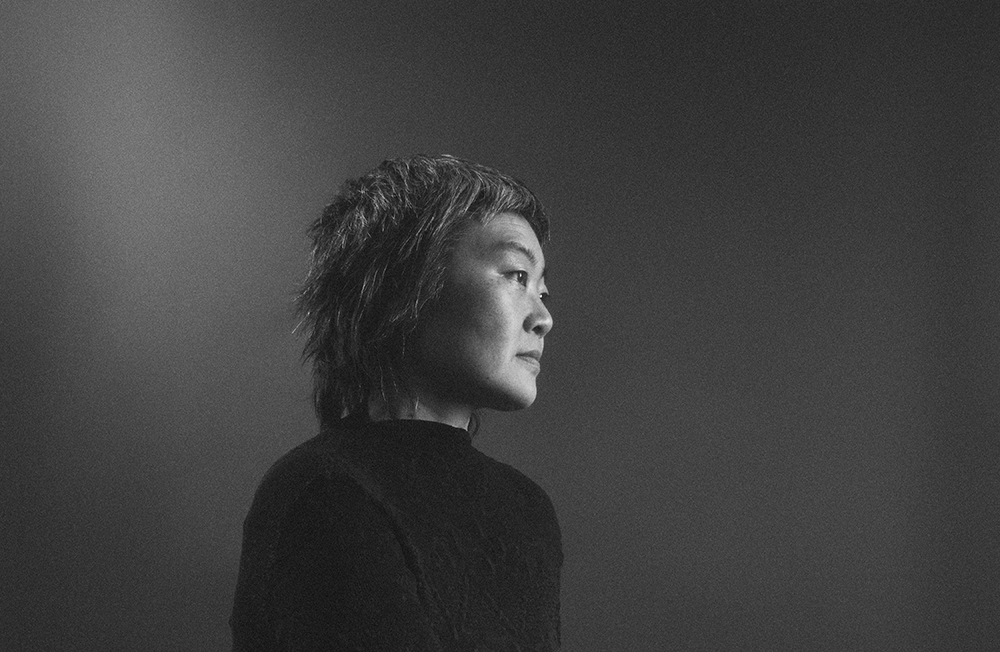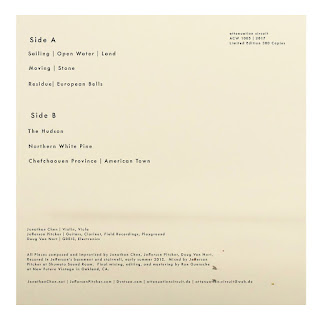Interview with Theresa Wong
Theresa Wong is a composer, cellist, vocalist, and intermedia artist active at the intersection of composition, improvisation, and the synergy of multiple disciplines. A 2024 Guggenheim Fellow in music composition, her works include Fluency of Trees for solo cello and voice which premiered at the Other Minds Festival in 2022, She Dances Naked Under Palm Trees, commissioned by pianist Sarah Cahill for The Future Is Female project, and Harbors, co-composed with Long String Instrument inventor Ellen Fullman and chosen as one of The Wire’s top 50 releases of 2020. Her multimedia piece The Unlearning, 21 songs inspired by Goya's Disasters of War etchings, premiered in 2013 at Roulette in Brooklyn and was also featured in the 2016 New Frequencies Festival at Yerba Buena Center for the Arts in San Francisco.
Recent commissions include works for San Francisco Girls Chorus, Peninsula Women's Chorus, NakedEye Ensemble, Long Beach Opera, Del Sol Quartet, and Splinter Reeds. She has shared her work internationally at venues including Fondation Cartier in Paris, Cafe Oto and Barbican Centre in London, San Francisco Asian Art Museum, Museo d'Arte Orientale in Torino, Sydney Festival, and The Stone in New York City. Wong is currently based in the San Francisco Bay Area.
1. There is a moment in life for every artist and musician to get inspired and move on towards a certain direction and commit to start doing what is closer to your interest? You also have been through different stages in your life related to different genres. Can you describe this (those) moment(s)?
Between 2001 to 2003, I was living in Venice and had a fellowship in design at Fabrica, an artistic research center in Treviso, Italy. My artistic awareness was greatly opened there through encounters with artists such as Lawrence Weiner, Koichi Makigami, Hamid Drake, and Fred Frith. That was a turning point that allowed me to envision a path forward as an artist working with music and sound creatively, bridging together my backgrounds in classical music and industrial design. Since then, I have been forging a practice which combines my interests in improvisation, composition, song forms, and intermedia performance.
I began collaborating with Long String Instrument inventor Ellen Fullman in 2006. Initially, I played some of her compositions and we performed in improvised settings. But around 2014, we began our first co-composition, Harbors. This really deepened my exploration in just intonation tuning. Our collaborative process has been extremely rich in discoveries in the areas of collaborative composition, sound engineering, tuning, instrumental development, and performance. In our second and most recent piece, Soundless, I also play an electric guitar tuned in just intonation as an extension of string exploration. I see this as another door opening into a vast world of sonic possibilities.
During the pandemic, I was commissioned by Long Beach Opera to create a piece for their 2020 Songbook. I created As We Breathe, which was made within the constraints of lockdown in collaboration with the LA-based baritone David Castillo. Because it had to premiere online as a film, it pushed me towards working in a more interdisciplinary way, creating what I call an ‘installed song’. I was able to combine all of my interests; song forms, composition, improvisation, visual design, and video in this work. This piece allowed me to see the possibilities of this new form, which I am currently developing on a larger scale in the form of an entire opera and installation.
2. In your work you use cello as your main instrument. How did you find your own way towards enjoying and using it for composition? How do you feel about it?
I began exploring the cello in a creative way during the fellowship at Fabrica. Even though I was there in the design department, I found my way to an electric cello and began improvising, composing, and working with other creative musicians in the music department and in the community. The cello has such expansive possibilities. Having direct physical contact with the strings and working with an unfretted fingerboard make the textural, timbral, and tuning possibilities on this instrument really vast.
3. Using certain technology to create music is a great idea but can also be a message. What drives you to create sounds using them? How did it evolve over the years of your personal experience?
Technology has always been vital to my process, even if most of my music is acoustically generated. My use of technology includes: using the recording process as a ‘sketchpad’ to compose, using recording technique (i.e. microphone placement) as an extension of composition, harmonically modifying pitches precisely on the cello and electric guitar and spatializing sound via Ableton Live, and composing in just intonation with software such as Pianoteq, Helmholtz-Ellis notation in Dorico, and creating custom made MIDI controller surfaces with Touch OSC. Early on, I was using guitar pedals with the cello but gradually shifted my focus to purely acoustic explorations because I felt the territory was so rich – I needed to start building from there first. I use amplification as a means of magnifying the complexity of these acoustic sounds. Now that I’ve been exploring that for almost 20 years, maybe I’m ready to add pedals back into the picture! I’m naturally moved to incorporate technology because it enables me to achieve certain desired outcomes, as mentioned in these various applications. Currently with my work developing ‘installed songs’, I am exploring the use of multimedia technology, like projection mapping and immersive and spatialized sound.
4. How do you set up for your live gigs? What approach do you have in terms of composing?
It really depends on the situation and material I’m performing. Currently, my solo setup consists of two DPA 4011 mics widely spaced and a Sennheiser MD431-II for voice, through stereo or four speakers (crossed panned to create a spatialized effect) plus a subwoofer. If I’m playing improvised music with others, I use one DPA 4011 or 4099 mic with my vocal mic through an Acoustic Image Clarion amp and Coda cabinet, which is a terrific little amp made for contrabass. In Soundless, my piece with Ellen Fullman, the cello is amplified with one mic and sometimes pitch shifted via Ableton Live. The electric guitar also goes through Ableton Live as a giant looper and harmonizer (I can select any single or combination of harmonics to add to the guitar signal). Both instruments are amplified through four or more speakers, spatialized in the performance setting. Sometimes, I play just acoustically, which I love if the space (i.e. amplifier) has good resonance.
When I compose, I usually have to spend time playing the instruments for which I’m writing. (This is how I started playing the electric guitar). A lot of my material comes naturally through improvising. In cases where I cannot play the instruments, like woodwinds, I work closely with performers to research and develop techniques with them.
5. How did you feel about collaborating with anyone before you met? What brought you together and how did you find the communication? Can you tell us a little bit about working with Ellen Fullman?
I love the excitement of working with someone for the first time. I have done this often in concerts of improvised music. I think there is a heightened sense of listening when you’ve never played with someone before.
Ellen and I met through the San Francisco Bay Area music scene. She had moved there in 2003 from Seattle, and I moved back that same year from Italy so we were both going to a lot of concerts and getting to know the music scene. We got together for a session to play a bit, which was really magical. I was really listening and open in a new way. But when we met for subsequent sessions, it was more difficult because I was not fluent in playing in just intonation, and everything I naturally did felt so out of tune because my fingers and ears were trained in equal temperament. So, I began to study tuning theory and map out the harmonics of the cello in order to navigate this terrain better. Our collaboration through these many years has been extremely fruitful and rich.
6. In an ever changing distribution of music how do you see your place and how do you feel about physical releases?
My role has been and will always be to create music, regardless of how it is distributed. Formats may come in and out of fashion, but our collective need for music will never go away. I embrace all formats – whether digital, analog, CDs, LPs, cassettes, etc. For my own label, fo’c’sle, I produced one LP but mostly release CDs and digital because it makes the most sense for small runs. Even though digital streaming has become the default for many people, I still feel that a physical release gives space and presence for a work of music in the world. However, I realize it also generates more material detritus, but digital releases lead to power consumption too – so I am hoping there will be a future format that really addresses the ecological repercussions of music distribution.
7. Could you tell us a bit about your latest album released by Room40 - Journey to the Cave of Guanyin?
In 2022, I was invited by Lawrence English of room40 to create an album stemming from my piece, Opening Sea (released on Practicing Sands), which explores a drone that mixes noise and harmonics on the cello using a detuned C-string. I began to germinate this seed during a 6-month period as a guest artist at the Asian Art Museum in San Francisco, where I was invited by Janet Oh to create pieces inspired by objects in the museum’s collection. The idea of creating a set of drone-like pieces felt fitting as a response to my fascination with the Chinese folklore of Guanyin, a deity whose name translates to ‘the one who perceives all the sounds, or cries, of the world’. Also known as Guanshiyin 觀世音, she is the embodiment of infinite compassion. I grew up knowing of Guanyin as a female deity, but discovered from the museum’s collection that she had transformed through the centuries from the male Hindu bodhisattva, Avalokiteśvara. I instantly found an affinity for this gender-fluid figure, who was said to have attained enlightenment through meditation on sound. I recorded the pieces between 2023-24, which turned out to be a period of intense challenges in my life. During 2024, I had a health crisis and could not listen to much music because it was too exhausting to my body. However, I could listen to these pieces on repeat, which gave me a sense of healing and calmness, which is fitting to their inspiration.
8. Plans for the future?
I am currently composing a piece for Del Sol string quartet for a project with poet Genny Lim, inspired by stories of the Asian American Diaspora which is set to premiere in October this year. I’m also laying groundwork for the opera performance and installation project I mentioned earlier, Vox Lumina (working title), which aims to shed light on the shadow qualities of marginalized identities that we hold within us. This piece will also include Del Sol quartet along with Radiance Vocal Ensemble, percussionist Haruka Fujii, vocalist Roco Córdova, and others to be determined. I’m currently an artist-in-resident at Kinosaito in upstate New York to develop this large-scale work, which will be presented by Other Minds in 2026.


Comments
Post a Comment